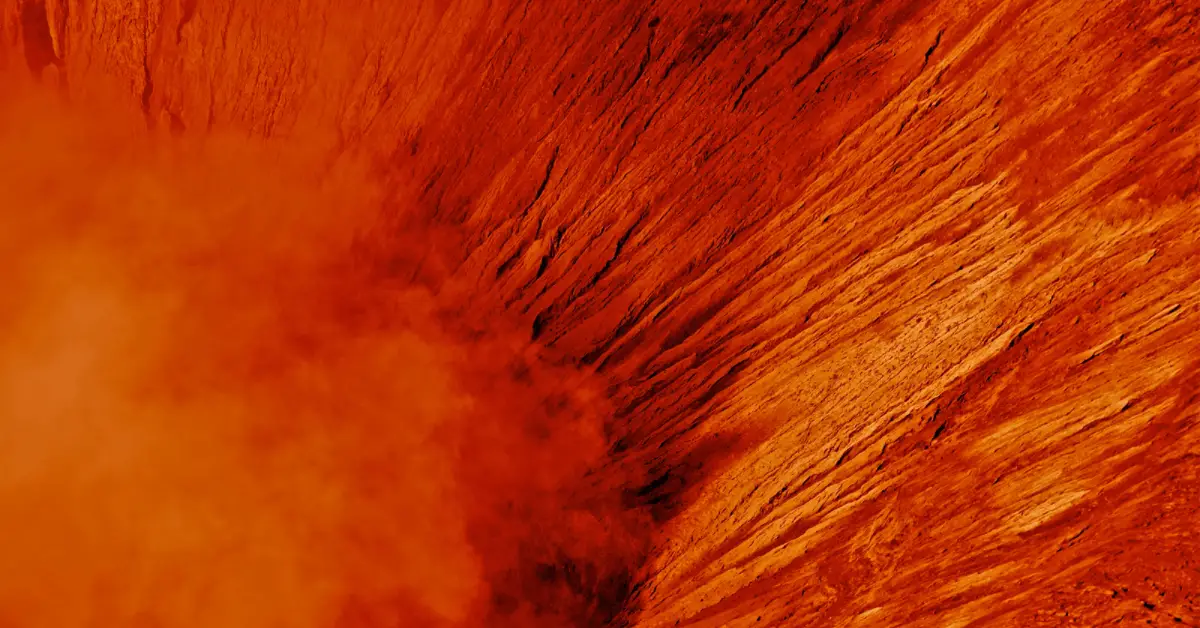- The atmosphere of Mars is surrounded by layers of several gases, mainly Carbon Dioxide having the highest ratio (95%) while other gases include traces of hydrogen, carbon monoxide, and other Noble gasses.
| Carbon Dioxide | 95% |
| Molecular Nitrogen | 2.8% |
| Argon | 2% |
| Molecular Oxygen | 0.174% |
| Methane | 10.5 ppb |
| Hydrogen | 15 ppm 40-50 ppm |
| Carbon Monoxide | 0.0747% |
| Sulphur Dioxide | 1-2 ppb |
(Measurements taken by Viking Landers 1970)
- A recent study shows that oxygen in the Martian atmosphere has seasonal changes and it rises up to 30% in spring and summer (measurements taken by NASA’s Curiosity Rover in 2019).
- Martian atmosphere consists of 43.3 g/mol of mean molecular weight (indicates the dominance of CO2).
- The Martian atmosphere contains traces of water vapours (0.03 mol%). Water vapour in the atmosphere comes through the process of sublimation. Sublimation occurs when ice on the poles (particularly in the Northern Hemisphere) shrinks due to warm temperatures (in summers) causing water to vaporize in the atmosphere.
- Though the planet is well known for having traces of ancient water, it is also believed that currently, Martian water exists underground or in ice caps.
- Mars has an atmospheric pressure at ground level (6.518 millibars) which is 0.095 psi, whereas Earth has 14.7 psi atmospheric pressure at sea level.
- At an altitude of 130 km, the pressure of Martian atmosphere is measured as 1/25th in comparison to earth.
- The highest recorded density of the planet (Mars) is ∼0.020 kg/m3.
- The Martian atmosphere contains 30 μSν per hour radiation and 240 to 300 mSv per year which is a relatively higher amount than Earth as Earth contains 0.21 mSv of radiation per year.
- Since Martian atmosphere is quite tenuous (thin) due to heavy solar winds and is enriched in Carbon Dioxide (95%), it is difficult for humans to breathe there.
- NASA’s perseverance rover has succeeded in making 5 grams of breathable oxygen (O2) which is sufficient for 10 minutes of breathing. Perseverance rover did it by splitting CO2 gas molecules from the atmosphere.
- Temperature on the planet (Mars) in summer can reach up to +70 degrees F (21.11 C) while during winter it can cross -220 degrees F (-140 C). Its atmosphere is relatively colder than Earth because it is further away from the Sun.
- It experiences heavy snowfall due to water ice caps on the northern side of the planet (detected by NASA’s Mars Phoenix Lander in 2008).
- It is believed that the atmosphere is leaking out gases and water vapours in space and the reason behind this particular circumstance is “changing seasons of Mars and wild dust storms”.
- The Martian atmosphere contains dust particles due to heavy dust storms produced by hot air (the heat comes from sunlight).
- The giant dusty blanket encircled around the planet can last up to several days/months due to which the Martian sky appears to be red and hazy.
- Martian atmosphere is quite thinner in comparison to Earth, therefore, human colonization on Mars is quite difficult or impossible without any artificial habitat.
- Many types of equipment such as; Mars suit, Energy equipment, resource extraction equipment (mainly for oxygen and water), Food production equipment etc are required to maintain such a complex life support system.
- Therefore, if humans went to Mars without any support system, they would die in a matter of seconds.
- Astronomers discovered that microbial life on Mars is detectable through biosignatures.
- Biosignatures are mainly gases and chemicals that are essential for life such as; oxygen, methane (NASA’s Curiosity rover has discovered methane gas on Gale Crater).
Mars and Earth’s atmosphere differences:
- Martian atmosphere is thought to be 100 times thinner than the Earth’s atmosphere.
- Mars has an atmospheric volume of 1% less than Earth while Earth has an atmospheric volume approx 5.18*1019 m3.
- Martian Atmosphere is mainly enriched in Carbon Dioxide whereas Earth primarily consists of oxygen and nitrogen gases.
- Mars has atmospheric pressure at ground level (6.518 millibars) which is 0.095 psi, whereas Earth has 14.7 psi atmospheric pressure at sea level.
- At an altitude (130 km) the pressure of Martian atmosphere is measured as 1/25th as that of Earth.
- Unlike Earth, Mars does not have a magnetic field of its own. Instead, the planet attains its magnetic field due to the current produced by Solar winds in the ionosphere of the planet.


